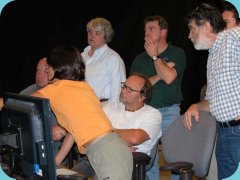 This is the first time that the chief scientist of an oceanographic expedition is leading the mission from shore, using technology to see what the team on the ship is seeing. Dr. Deborah Kelley is at the Science Control Center at the University of Washington (UW). From there, she and her team can see all of the video coming from the remotely operated vehicle (ROV) cameras. They can tell the team on the ship where to drive the ROVs and which rock samples to collect. The two teams are constantly communicating using our satellite and Internet 2 link.
This is the first time that the chief scientist of an oceanographic expedition is leading the mission from shore, using technology to see what the team on the ship is seeing. Dr. Deborah Kelley is at the Science Control Center at the University of Washington (UW). From there, she and her team can see all of the video coming from the remotely operated vehicle (ROV) cameras. They can tell the team on the ship where to drive the ROVs and which rock samples to collect. The two teams are constantly communicating using our satellite and Internet 2 link.
 It is interesting to see the two teams working together using technology. During a dive, they use an intercom system to talk back and forth. Often you can hear the ROV pilot talking with a scientist at UW about how to move the vehicle. Getting a rock sample with Hercules' robotic arm can be tricky. Once, when they finally grabbed the rock, both scientist and pilot shouted “Yes!†over the intercom. It sounded like they were working together in the same room even though they were 4,500 miles apart and talking over a satellite!
It is interesting to see the two teams working together using technology. During a dive, they use an intercom system to talk back and forth. Often you can hear the ROV pilot talking with a scientist at UW about how to move the vehicle. Getting a rock sample with Hercules' robotic arm can be tricky. Once, when they finally grabbed the rock, both scientist and pilot shouted “Yes!†over the intercom. It sounded like they were working together in the same room even though they were 4,500 miles apart and talking over a satellite!
 While it looks easy, this kind of operation takes a lot of planning and coordination. The team must also communicate with the crew on the bridge of the Ronald H. Brown who must keep the ship in position over the Lost City site. Only one person – the navigator – is allowed to talk to the bridge. The navigator keeps track of the positions of the ship and both ROVs. When the pilot or the scientist wants the ship to move, they must tell the navigator first, who communicates with the ship's crew on the bridge. It's a careful dance, but when it goes well, we can get a lot of science done at sea.
While it looks easy, this kind of operation takes a lot of planning and coordination. The team must also communicate with the crew on the bridge of the Ronald H. Brown who must keep the ship in position over the Lost City site. Only one person – the navigator – is allowed to talk to the bridge. The navigator keeps track of the positions of the ship and both ROVs. When the pilot or the scientist wants the ship to move, they must tell the navigator first, who communicates with the ship's crew on the bridge. It's a careful dance, but when it goes well, we can get a lot of science done at sea.
 This is the first time that the chief scientist of an oceanographic expedition is leading the mission from shore, using technology to see what the team on the ship is seeing. Dr. Deborah Kelley is at the Science Control Center at the University of Washington (UW). From there, she and her team can see all of the video coming from the remotely operated vehicle (ROV) cameras. They can tell the team on the ship where to drive the ROVs and which rock samples to collect. The two teams are constantly communicating using our satellite and Internet 2 link.
This is the first time that the chief scientist of an oceanographic expedition is leading the mission from shore, using technology to see what the team on the ship is seeing. Dr. Deborah Kelley is at the Science Control Center at the University of Washington (UW). From there, she and her team can see all of the video coming from the remotely operated vehicle (ROV) cameras. They can tell the team on the ship where to drive the ROVs and which rock samples to collect. The two teams are constantly communicating using our satellite and Internet 2 link.
